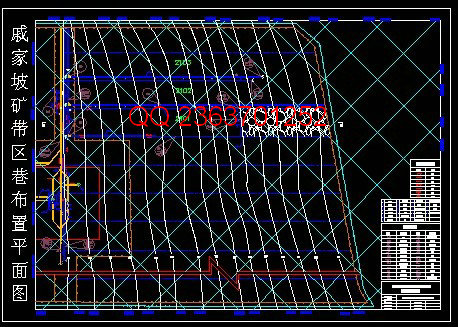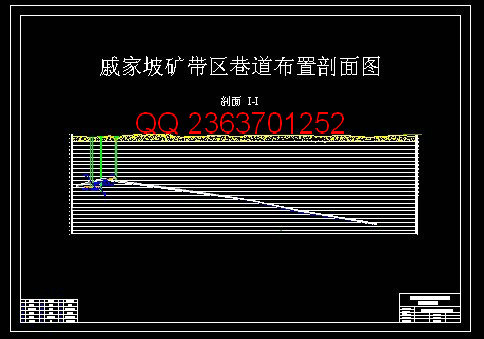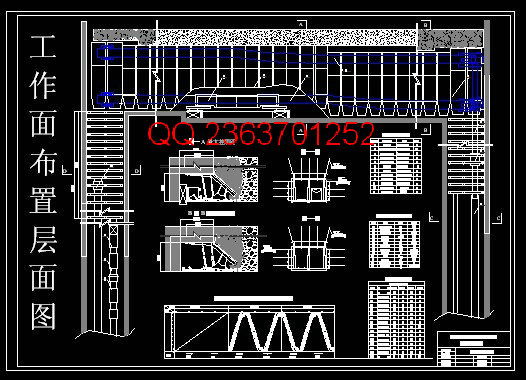|
设计描述:
文档包括:
设计说明书1份,共134页,约70000字左右
CAD版本图纸,共5张
毕业设计任务书
毕业设计题目: 戚家坡煤矿0.9 Mt/a新井设计
毕业设计专题题目: 动压巷道的底鼓控制技术研究
毕业设计主要内容和要求:
毕业设计主要内容包括一般部分、专题部分和翻译部分,还包括绘制五张大图,分别为矿井开拓平面图、矿井开拓剖面图、采区巷道布置平面图、采区巷道布置剖面图、采煤方法图。
毕业设计一般部分是在新桥矿井的实际地质条件基础上,按照毕业设计大纲的要求进行的,完成了大纲规定的全部工程量。毕业设计的专题部分提出了新桥煤矿巷道支护专家系统设计思路。完成这部分内容时,发挥了自己的创造能力,在内容、方法或结论的方面达到了尽可能的创新。
摘 要
本设计包括三个部分:一般部分、专题部分和翻译部分。
一般部分为戚家坡煤矿0.9Mt/a新井设计。戚家坡煤矿位于宝鸡市西北千阳县与陇县交界处的戚家坡村,该矿距宝鸡市60km,交通便利。井田南北倾斜宽3.2km,东西走向长3.7km,井田面积11.87km2。井田内有上、下两层煤,主采煤层为下层煤,煤层倾角8 ~12 ,平均倾角为10 ,煤层平均总厚为8.0m。井田地质条件较为简单。
井田工业储量8978万t,矿井可采储量5364万t。矿井服务年限为45.8a,矿井正常涌水量为5.8m3/h,最大涌水量为7.5 m3/h。矿井绝对瓦斯涌出量为5.67 m3/min,为低瓦斯矿井。
井田为立井单水平开拓。大巷3t底卸式矿车运煤,辅助运输采用1t矿车和平板式矿车。矿井通风方式为抽出式通风。
矿井年工作日为330d,工作制度为“三八”制。
一般部分共包括10章:1、矿区概述及井田地质特征;2、井田境界和储量;3、矿井工作制度及设计生产能力;4、井田开拓;5、准备方式-带区巷道布置;6、采煤方法;7、井下运输;8、矿井提升;9、矿井通风与安全技术;10、矿井基本技术经济指标。
专题部分题目是动压巷道的底鼓控制技术研究,主要是研究了深井开采巷道承压较大情况下巷道发生底鼓的机理、类型及防治措施。
翻译部分主要内容为研究深矿区地下水的运动特征,解决咸水入侵分区的分布规律与水平方向溶隙水分区相矛盾的问题。英文题目为:Movement characteristics of Karst water in a deep mining area
ABSTRACT
This design includes of three parts: the general part, special subject part and translated part.
The general part is a new design of Qijiapo mine. Qijiapo coal lies in the Northwest Qianyangxian, an adjoining town of Longxian in the city of Baoji, ShangXi province. The traffic of road and railway is very convenience to the coal. The run of the minefield is 3.2km,the width 3.7km,the well farmland total area is 11.87km2. There are two seams of coal,The Lower is the main coal seam, and its dip angle is 8degree. The thickness of the mine is about 8.0m in all. Geologic structure of coalfield is simple.
The proved reserves of the minefield are 89.48 million tons,and the recoverable reserves are 56.34 million tons. The designed productive capacity is 0.9 million tons percent year, and the service life of the mine is 45.8 years. The normal flow of the mine is 5.8m3 percent hour and the max flow of the mine is 7.5 m3 percent hour. The mineral well gas gushes is lower, It is a low gas mineral well.
The mine is a single level in an vertical well to expand. Te central laneway use Hoppers type harvesters of 3.0t to transit coal, Fixed harvesters and peaceful type harvesters of 1.0t are used for accessorial transportation in te roadway.
The working system “three-eight” is used in the Mugua mine. It produced 330 d/a.
This design includes ten chapters: 1.An outline of the mine field geology; 2.Boundary and the reserves of mine; 3.The service life and working system of mine; 4.development engineering of coalfield; 5.The layout of belt; 6. The method used in coal mining; 7. Transportation of the underground; 8.The lifting of the mine; 9. The ventilation and the safety operation of the mine; 10.The basic economic and technical norms.
The topic of special subject parts is Dynamic pressure of roadway bottom control echnology research. The Deep mining is mainly studied roadway tunnels circumstances occur pressure greatly the mechanism, type and preventive measures.
Translation part is about the. study the movement characteristics of groundwater in a deep mining area and solve the dispute of the distribution rule of hydrochemical zoning which is contradicted by lixiviation water zoning in a horizontal direction,It’s english topic is Research of Fire Hazard Critical Guidelines of Mine Use Belt Conveyor and Automatic Fighting Fire System.
目 录
一般部分
1 矿井概况与地质特征 1
1.1矿区概述 1
1.1.1地理位置与交通 1
1.1.2地形地貌及水系 1
1.1.3气象及地震情况 2
1.1.4矿区经济概况,工业、农业、劳动力、建筑材料情况 2
1.2井田地质特征 2
1.2.1地层 2
1.2.2井田地质构造 3
1.2.3水文地质 3
1.2.4矿井涌水量 5
1.3煤层特征 5
1.3.1煤层 5
1.3.2煤质 6
1.3.3 煤层开采技术条件 7
2 井田境界和储量 9
2.1 井田境界 9
2.2 矿井工业储量 9
2.3 矿井可采储量 11
3 矿井工作制度、设计生产能力及服务年限 14
3.1 矿井工作制度 14
3.2 矿井设计生产能力及服务年限 14
3.2.1 确定依据 14
3.2.2 矿井设计生产能力 14
3.2.3 矿井服务年限 15
3.2.4 井型校核 15
4 井田开拓 17
4.1井田开拓的基本问题 17
4.1.1确定井筒形式、数目、位置及坐标 17
4.1.2工业场地的位置 19
4.1.3开采水平的确定及采(带)区的划分 19
4.1.4开拓方案比较 20
4.2矿井基本井筒巷道 26
4.2.1井筒 26
4.2.2井底车场 29
4.2.3开拓巷道 31
5 准备方式—带区准备方式 34
5.1煤层地质特征 34
5.1.1带区位置 34
5.1.2 带区煤层特征 34
5.1.3 煤层顶底板岩石构造情况 34
5.1.4 水文地质 34
5.1.5 地质构造 35
5.2 带区巷道布置及生产系统 35
5.2.1 带区准备方式的确定 35
5.2.2带区巷道布置 35
5.2.3 带区生产系统 36
5.2.4 带区内巷道掘进方法 38
5.2.5 带区生产能力及采出率 38
5.3带区车场选型设计 40
6 采煤方法 42
6.1采煤工艺方式 42
6.1.1 带区煤层特征及地质条件 42
6.1.2 确定采煤工艺方式 42
6.1.3 回采工作面参数 43
6.1.4回采工作面破煤、装煤方式 44
6.1.5 采煤工作面支护方式 46
6.1.6 放顶煤参数确定 47
6.1.7 回采工作面劳动组织和正规循环作业 48
6.2回采巷道布置 51
6.2.1回采巷道布置方式 51
6.2.2回采巷道参数 52
7 井下运输 56
7.1概述 56
7.1.1井下运输原始数据 56
7.1.2 矿井运输系统 56
7.2 煤炭运输方式和设备的选择 57
7.2.1 煤炭运输方式的选择 57
7.2.2 带区煤炭运输设备选型及验算 57
7.2.3 运输大巷设备选择 60
7.3 辅助运输方式和设备选择 60
7.3.1 辅助运输方式选择 60
7.3.2 辅助运输设备能力验算 60
8 矿井提升 63
8.1矿井提升概述 63
8.2主副井提升 63
8.2.1主井提升 63
8.2.2副井提升设备选型 64
9 矿井通风与安全 67
9.1 矿井概况、开拓方式及开采方法 67
9.1.1 矿井地质概况 67
9.1.2 开拓方式 67
9.1.3 开采方法 67
9.1.4 变电所、充电硐室、****库 67
9.1.5 工作制、人数 68
9.2 矿井通风系统的确定 68
9.2.1 矿井通风系统的基本要求 68
9.2.2 矿井通风方式的选择 68
9.2.3 矿井主要通风机工作方式的选择 69
9.2.4 带区通风系统的要求 70
9.2.5 工作面通风方式的选择 70
9.3 矿井风量计算 71
9.3.1 工作面所需风量的计算 71
9.3.2 备用面需风量的计算 73
9.3.3 掘进工作面需风量 73
9.3.4 硐室需风量 74
9.3.5 其它巷道所需风量 74
9.3.6 矿井总风量计算 74
9.3.7 风量分配 75
9.4 矿井通风阻力计算 75
9.4.1 容易和困难时期矿井最大阻力路线确定 76
9.4.2 矿井通风阻力计算 81
9.4.3 矿井通风总阻力计算 82
9.4.4矿井总风阻和等积孔计算 83
9.5选择矿井通风设备 83
9.5.1选择主要通风机 83
9.5.2电动机选型 85
9.6安全灾害的预防措施 86
9.6.1预防瓦斯和煤尘爆炸的措施 86
9.6.2预防井下火灾的措施 86
9.6.3防水措施 86
10 设计矿井基本技术经济指标 88
专题部分
动压巷道底鼓控制技术研究 90
翻译部分
英文原文 112
中文译文 119
致 谢 124
| 









